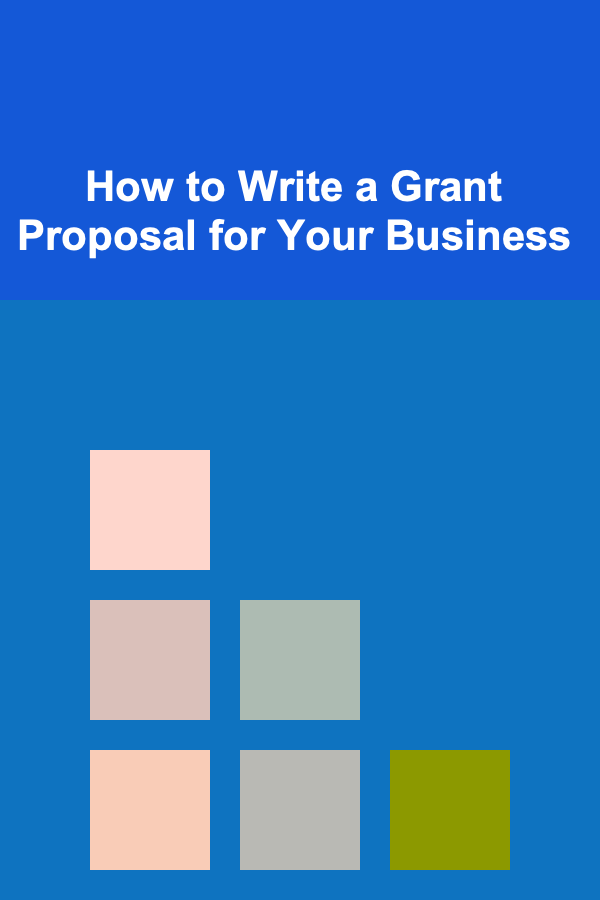
How to Write a Grant Proposal for Your Business
ebook include PDF & Audio bundle (Micro Guide)
$12.99$9.99
Limited Time Offer! Order within the next:

Writing a grant proposal is a vital skill for entrepreneurs and business owners looking to secure funding for their projects, initiatives, or startups. Grants offer a unique opportunity for businesses to receive non-repayable funds from government agencies, foundations, or private organizations. However, the competition for grants can be fierce, and crafting an effective grant proposal is key to improving your chances of success.
In this article, we will explore the process of writing a grant proposal for your business in-depth. From understanding the types of grants to structuring your proposal and aligning it with the funder's objectives, this guide will provide you with the tools needed to write a compelling proposal that stands out.
Understanding Grants and Their Importance
Before diving into the technicalities of writing a grant proposal, it's essential to first understand what grants are and why they are beneficial to your business.
A grant is a financial award provided by a government body, non-profit organization, or corporation to fund specific projects or initiatives that align with the funder's goals and priorities. Unlike loans, grants do not need to be repaid, making them a highly attractive option for businesses, especially startups and small enterprises.
Types of Grants Available for Businesses
There are various types of grants available for businesses depending on your location, industry, and business goals. Some common types include:
- Government Grants: These are typically provided by national, state, or local government agencies to support businesses that contribute to public welfare, innovation, or research.
- Corporate Grants: Some large corporations offer grants to support small businesses or specific industries related to their operations.
- Nonprofit and Foundation Grants: These grants are offered by nonprofit organizations, foundations, or philanthropic groups to support businesses that align with their mission and goals.
- Research and Development Grants: If your business is involved in innovation, scientific research, or product development, you may be eligible for grants aimed at fostering innovation.
Understanding the type of grant you're applying for is crucial because each grant comes with its own set of requirements and criteria.
Preparing to Write a Grant Proposal
Before you begin writing your proposal, there are several preparatory steps you should take to ensure that you have a clear and focused approach to your application.
Step 1: Research the Grant Provider
The first step in writing a grant proposal is researching potential grant providers. Whether it's a government agency, foundation, or corporation, each funding source has its own set of eligibility requirements, priorities, and guidelines.
Take time to thoroughly review the grant provider's mission, goals, and areas of focus. This will help you determine if your business aligns with their objectives and increase your chances of approval. Understanding the specific criteria and evaluation process will also help you craft a proposal that speaks directly to their needs.
Step 2: Understand the Requirements and Guidelines
Each grant provider has its own application process and set of guidelines. Carefully review the Request for Proposal (RFP) or Grant Application documents to understand the eligibility requirements, budget restrictions, project timeline, and necessary documentation.
The guidelines often include:
- Specific objectives or outcomes that the funder is seeking to achieve.
- Required documents (e.g., business plans, financial statements, legal documents).
- Formatting requirements (e.g., word count, font size, and layout).
- Deadlines and submission instructions.
By adhering to the provided guidelines, you ensure that your proposal is considered for funding.
Step 3: Gather Necessary Documents
Many grant proposals require specific documents that support your application. These may include:
- Business Plan: A detailed business plan outlines your business objectives, market analysis, organizational structure, financial projections, and strategy. It helps the funder understand the potential of your business.
- Financial Statements: Most grant providers want to assess the financial health of your business. Be ready to provide your balance sheet, income statement, and cash flow statement.
- Legal Documents: You may need to submit your business's registration documents, tax ID, and any certifications or licenses.
- Project Proposal or Plan: If your grant proposal is for a specific project, you'll need to outline the project's scope, timeline, and expected outcomes.
Having these documents prepared ahead of time will streamline the writing process and show the funder that you are serious and organized.
Writing the Grant Proposal
Now that you have a solid foundation, it's time to begin writing your grant proposal. A well-written proposal is clear, concise, and directly addresses the funder's priorities. Below is a step-by-step guide to help you structure your grant proposal effectively.
1. Executive Summary
The executive summary is the first section of your grant proposal, and it serves as an overview of your business and the project you are seeking funding for. Although it appears at the beginning of your proposal, it's often best to write it last so that it accurately reflects the content of the entire proposal.
Key components of an executive summary include:
- A brief description of your business.
- The problem or need your business addresses.
- A summary of the project you are seeking funding for.
- The amount of funding requested.
- Expected outcomes and the impact on your business or community.
Your executive summary should be compelling and concise, typically no more than one to two pages. Remember, this section may be the only part that some funders read in detail, so make it count.
2. Problem Statement or Needs Assessment
In this section, you will explain the problem your business is solving or the need your project addresses. This is where you demonstrate why your business is important and why funding is needed.
Describe:
- The current market conditions or societal issue.
- Why this problem is significant.
- How your business or project will address this problem.
Use data, research, and statistics to substantiate your claims. Funders want to know that there is a genuine need for the project or business, and they want to be confident that their investment will have a meaningful impact.
3. Project Goals and Objectives
Once you've identified the problem or need, the next step is to outline the goals and objectives of your project. This section should describe the outcomes you hope to achieve and how the grant funding will help you reach these goals.
Clearly define:
- What you plan to accomplish with the funding.
- The specific objectives or milestones of the project.
- How success will be measured.
Funders want to know how their investment will be used and how you will evaluate the success of the project. Provide measurable and achievable goals to give the funder confidence in your ability to deliver results.
4. Project Design and Implementation
In this section, you will outline the project design and implementation plan. This should include detailed information about how the project will be carried out from start to finish.
Consider including:
- The project timeline, including key milestones and deadlines.
- The roles and responsibilities of your team.
- A description of the activities involved in the project.
- Resources and tools needed to carry out the project.
Be as specific as possible to demonstrate that you have thought through the practical aspects of the project and have a plan in place to execute it successfully.
5. Budget and Financial Information
The budget section is one of the most critical parts of the grant proposal. A clear and realistic budget helps the funder understand how the grant money will be spent and ensures that your project is financially viable.
Include:
- A detailed breakdown of project costs (e.g., labor, materials, equipment, marketing).
- Justifications for each expense.
- Any other sources of funding or revenue (if applicable).
Be transparent and honest about your costs, and ensure that your budget aligns with the funder's guidelines and expectations.
6. Evaluation Plan
An evaluation plan outlines how you will measure the success of your project. Funders want to know that the project will be evaluated and that their investment will lead to meaningful outcomes.
Describe:
- The methods and tools you will use to measure progress.
- How often you will assess the project.
- The indicators of success.
Including an evaluation plan shows that you are committed to ensuring the project's success and that you will track its progress effectively.
7. Conclusion
In the final section of your proposal, briefly restate the importance of your business or project and the value of the funding. Express gratitude for the opportunity to apply and invite the funder to contact you with any further questions.
Keep your conclusion positive and focused on the potential impact of the project.
Finalizing the Proposal
Once you've written your proposal, it's time to finalize it. Follow these steps before submitting your grant application:
Step 1: Review and Revise
Carefully review the proposal for clarity, coherence, and adherence to the funder's guidelines. Make sure your proposal is well-organized and free from grammatical errors. If possible, have someone else read through it for feedback.
Step 2: Check Compliance with Guidelines
Ensure that your proposal complies with the specific guidelines set forth by the grant provider. This includes formatting requirements, document submissions, and deadlines.
Step 3: Submit the Proposal
Once you've completed your review, submit your proposal according to the grant provider's instructions. Some grant applications may require electronic submissions, while others may require physical copies.
Conclusion
Writing a grant proposal for your business can be a time-consuming and challenging task, but with careful preparation, attention to detail, and a clear understanding of the funder's goals, you can significantly improve your chances of success. By following the steps outlined in this guide, you'll be able to craft a compelling proposal that showcases your business's potential and the impact of your project.
Remember, securing a grant is just the beginning. Maintaining transparency, providing progress updates, and delivering on your project's promises are key to building a lasting relationship with the grant provider and ensuring future funding opportunities.

Data Scientist's Toolkit: Advanced Methods and Tools for Data-Driven Decision Making
Read More
How to Boost Your Energy with Proper Nutrition
Read More
How to Sell Used Fitness Equipment on Facebook Marketplace: An Actionable Guide
Read More
How to Advocate for Freshwater Ecosystem Conservation
Read More
How to Use Spreadsheets to Track Child Support and Alimony
Read More
How to Navigate Flight Attendant Crew Schedules
Read MoreOther Products

Data Scientist's Toolkit: Advanced Methods and Tools for Data-Driven Decision Making
Read More
How to Boost Your Energy with Proper Nutrition
Read More
How to Sell Used Fitness Equipment on Facebook Marketplace: An Actionable Guide
Read More
How to Advocate for Freshwater Ecosystem Conservation
Read More
How to Use Spreadsheets to Track Child Support and Alimony
Read More